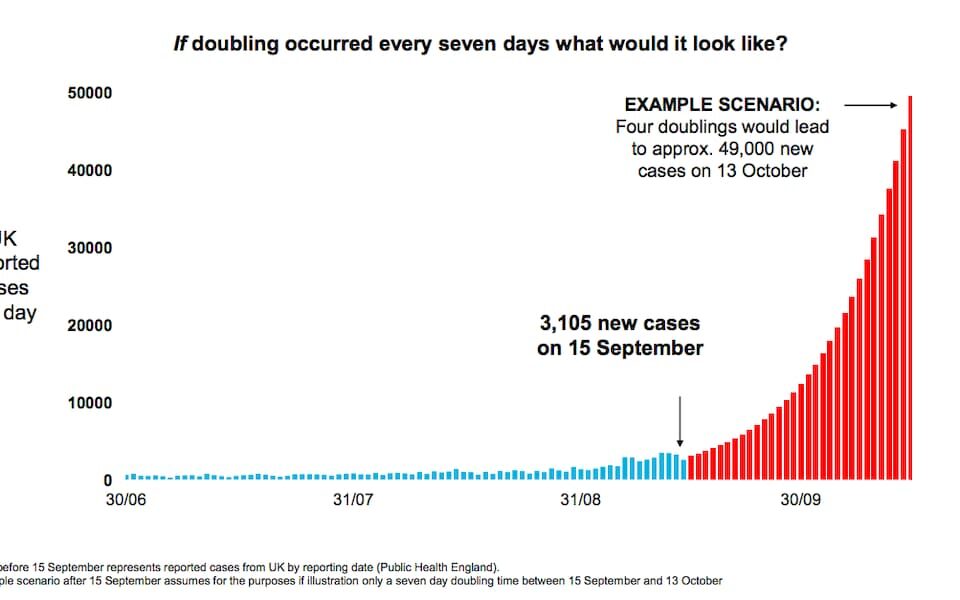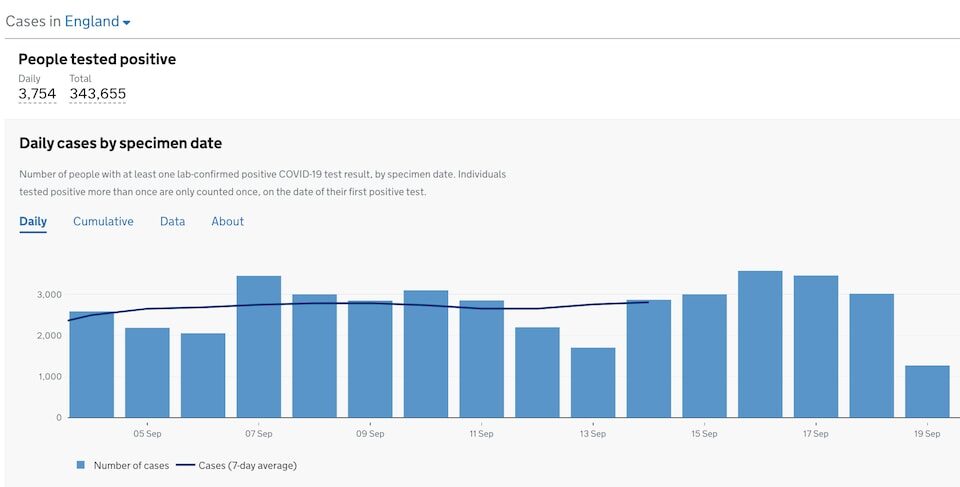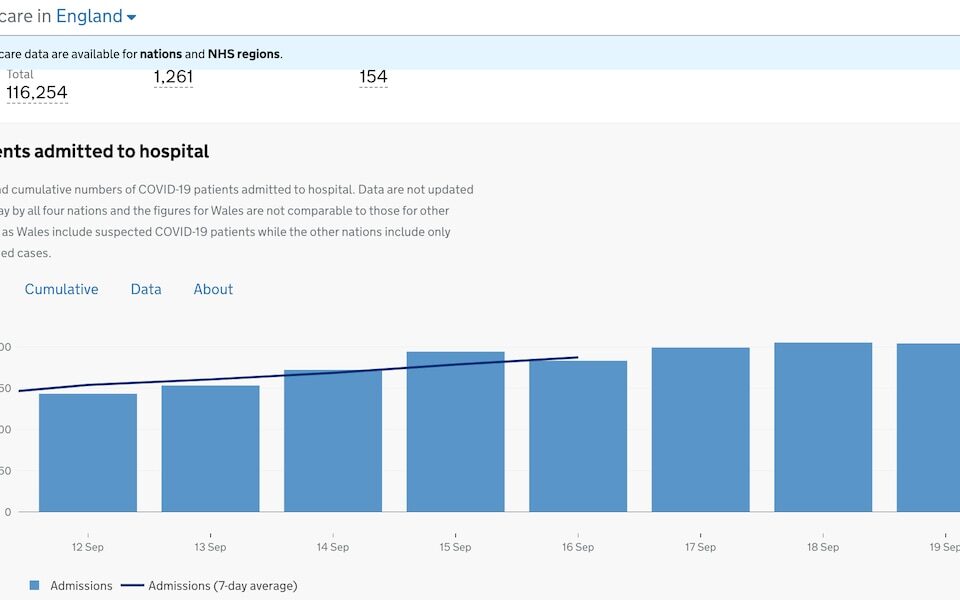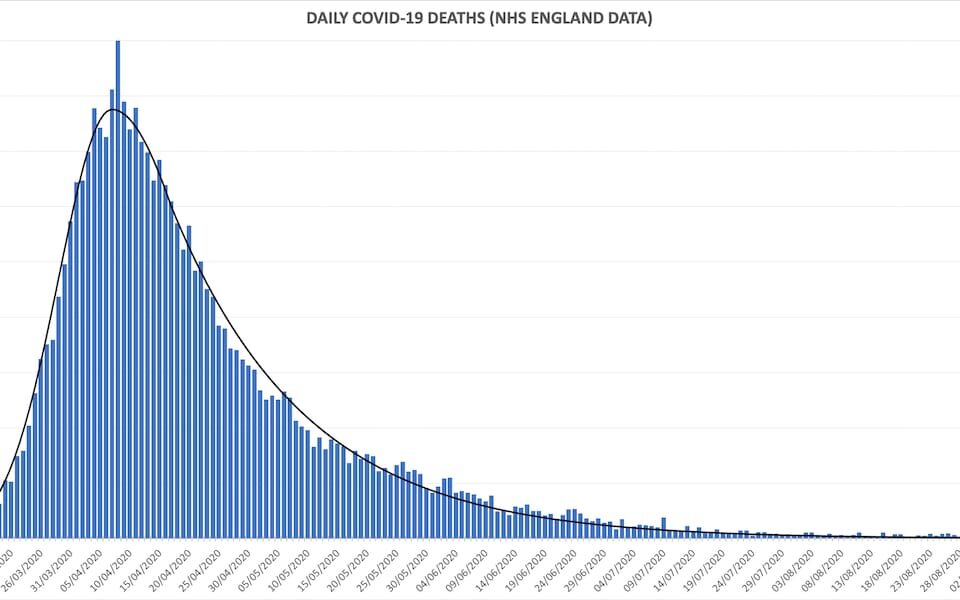When Chris Whitty and Sir Patrick Vallance gave an update on the Covid situation yesterday, they were addressing a public that is largely frightened, puzzled, or a combination of the two.
Yet the press conference will have done little to abate these feelings; at times it appeared a deliberate attempt to stoke panic.
The 'highlight' of their announcements was a bizarre chart that showed current UK 'cases' (positive tests) reaching a higher level than in summer, as might be expected (respiratory viral diseases tend to disappear in summer and bounce back when we spend more time indoors as the seasons change) before apparently reaching a plateau (blue bars).
Then followed a seemingly unrelated exponential chart, showing what could happen if cases start doubling every seven days. Though Vallance made it clear that this was projection rather than prediction, in the current febrile atmosphere we should not expect this crucial disclaimer to be mentioned when the chart is reproduced - something the government must surely have been aware of.

The government's chart from yesterday's press conference, showing exponential growth
If doubling occurred every seven days what would it look like? The trajectory set out in the red bars, doubling every seven days, implies cases growing by 10 per cent daily. This seems an odd decision.
Sage's latest forecast suggests an increase of between 2 and 7 per cent per day. Why did they choose to omit this range?
In their slides, Whitty and Vallance chose to use daily reported case numbers, reflecting the constipation in the testing system when schools went back, rather than by the date the tests were actually taken (surely a better measure of the disease's spread?).
Looking at positive tests on the day specimens were actually taken, it's not at all clear that there has been any significant recent growth in cases at all, and certainly nowhere near doubling every week.
Cases by specimen date (NHS figures)
Vallance then warned us that 50,000 cases per day by mid-October would likely result in 200 deaths per day.
An obvious point here is that 'cases' in his chart are positive tests, not necessarily symptomatic sick people. Current case positivity stands at a little over 1 per cent, so to detect 50,000 cases might imply that testing has increased to around 5 million per day in the next three weeks. Now that's a moonshot.
The weekly ONS incidence survey suggests that levels of infection are not (yet) noticeably increasing in the vulnerable 70+ age group even as the virus passes through the young, and this pattern is confirmed by the age patterns in those seeking triage through the dedicated 111 covid service. Yet, oddly, this was not mentioned.
The chart showing international case comparisons - which once featured a range of OECD nations - has now, apparently, reached the knockout stages, with only hard-hit France and Spain left to scare us on the charts.
In Free Sweden, cases are not growing at all, but perhaps including the Swedes might have blunted the impact?Yesterday's presentation also suffered from a fatal lack of perspective:
recent daily deaths with covid are under 2 per million in both France and Spain, less than a tenth of the levels in Spring's first wave. But this was nothing to the misrepresentation which followed in the Commons after the press conference, when Health Secretary Matt Hancock warned MPs thay the numbers of people with Covid in Europe is now "higher than it was in March", without reference to the massive expansion of testing which has occurred since then.The next slide was the increase in English covid hospital admissions (including, though this point wasn't mentioned, people testing positive for hospital-acquired infections) - again, indisputably running at a higher level than summer. Mystifyingly though,
the chart cut off at 16 September showing admissions at around 200 per day, even though the government's dashboard shows that this level has been steady for five days: to make an obvious point, if it isn't clear that numbers are growing at all, they certainly aren't growing exponentially.
Patients admitted to hospital (NHS England data)
After all the stick, the carrot at the end was that there might (implying 'might not') be progress on the vaccine front. They didn't mention that the
Oxford/AstraZeneca trial is still suspended (in the USA): it's difficult to believe that a safe, effective, and widely available vaccine can be imminent. Six months ago the vaccine was six months away, which still seems to be the case. The vaccine didn't help us in the first wave and it won't help us in the second.
Several dogs didn't bark in the presser, most significantly the impact of lockdown on non-covid care. Cancer Research UK estimate that around 3 million people are awaiting basic screening due to lockdown-related disruption, with 350,000 fewer people being urgently referred with suspected cancer symptoms. These numbers are not in the same ballpark as even the gloomiest covid projections made today. A pivot from a narrow focus on covid to a broader discussion of the nation's health seems long overdue.
Given that it is likely the only metric that history will remember, why too was there no chart showing how many people are actually dying of the disease? Perhaps because showing the first wave would have helped put the second in perspective.
Daily reported deaths (NHS England data)
There was no grappling with the interesting scientific question of false positive rates in an environment of low prevalence - mathematically, this could suggest that a high proportion of positive tests are either false or non-infectious "weak" positives; perhaps that was left for another day.
There was also no talk of how antibody levels might impact on the trajectory of infections, given that (as recent SAGE minutes put it) "some groups are more central to transmission to others... the first 6 per cent of the population to become immune will reduce transmission by more than 6 per cent". Another odd omission, given this feeds directly into the plan outlined by Vallance in March, of protecting the vulnerable while the virus passes through the healthy.
No mention either of where outbreaks are found, even though last week's surveillance figures show nearly ten times as many acute respiratory covid infections being traced to care homes compared to restaurants and other food outlets, despite the latter being on the block for likely "interventions".
The presser was billed as laying a breadcrumb trail for further measures to be announced by Number Ten, but tellingly, the scientists were not flanked by any politicians. Perhaps there is disagreement within Cabinet, and between the devolved administrations, about quite how clear the data really is and quite how much intervention is required.
Soon we will learn how many more liberties will be curtailed to flatten a curve that might not need flattening at all. True, it is still only September; it may yet become clear that another flu d'état is required to squash a sombrero - but that time is not now.
Alistair Haimes has worked with data professionally for 25 years.
Reader Comments
to our Newsletter